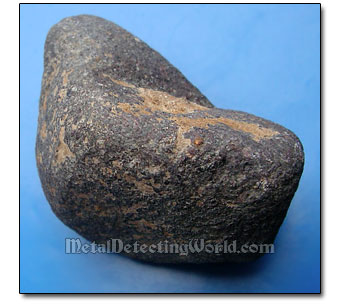Hot Rocks are pebbles or rocks that contain more nonconductive or conductive minerals than the surrounding ground to which a metal detector is balanced automatically or manually.
This is why, when the hot rocks are in the detector's electromagnetic field, they disturb the ground balance of the metal detector so intensively that the machine reads them as metal targets, i.e. the hot rocks generate positive or false metallic audio signals which slightly vary in pitch tone from one area to another.
Hot rocks can contain either a mineral density (pebbles) or mineral quantity (large rocks), or both. Most hot rocks contain high concentrations of the iron-bearing minerals which are predominately the iron oxides: magnetite, maghemite, hematite, limonite and lepidocrocite. Other hot rocks contain high concentrations of either nonmetallic but highly conductive carbon mineral (graphite) or nonferrous metals such as copper, aluminum, manganese, nickel, cobalt and even gold. Most common hot rocks in the US are basalt (magnetite-rich rock), magnetite and hematite.
The IRON-BEARING hot rocks are the most common and can be divided in two types:
Type I: NEGATIVE Hot Rocks
Negative hot rocks (also called "cold rocks") are more nonconductive than the surrounding ground matrix, and their Ground Balance values are higher than the Ground Balance value of soil they are in. This is why, the small, pebble-sized (mineral density) negative hot rocks generate negative signals in the All-Metal Motion Discriminate mode. However, large negative hot rocks (mineral quantity) at shallow depths cause a metal detector to respond with positive or false-metallic audio responses.
Negative hot rocks are highly nonconductive (magnetic) because they contain mostly high concentrations of Magnetite. They are dark in color, often heavy due to their high iron content, usually attracted to a magnet and, in some cases, stained with rust.
Magnetite (chemical formula Fe3O4) is an iron (II, III) oxide - one of the three common naturally occurring iron oxides, and the most magnetic (shows strong properties of Ferrimagnetism) of all the naturally occurring minerals on Earth. The sand-sized particles of Magnetite are called "Black Sand" (mineral sand or iron sand) which is sometimes found in large quantities in beach sand, streams and dry-washes in the gold-bearing regions. Usually a good indication of the gold-bearing area is an excessive presence of magnetite in the ground. This is why the negative hot rocks are abundant in many goldfields around the world. Magnetite also occurs in meteorites.
